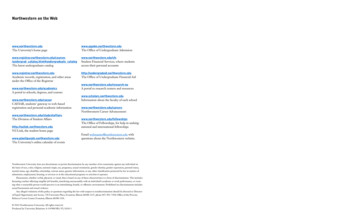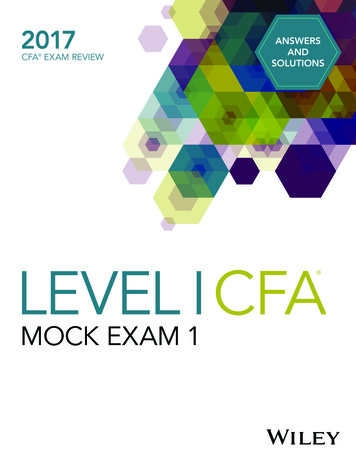
Transcription
CFASimone Campanonisimonec@eecs.northwestern.edu
Outline CFA and a first example: dominators Another example of CFA: Post-dominators Example of CFA and CFT: basic block merging and splitting
Control Flow Analysis Storing order executing order Control Flow Analyses are designedto understand the possible execution paths (control flows)while ignoring data values and operations/operators We need to identify all possible control flowsbetween instructions We need to identify all possible control flowsbetween basic blocks Let’s look at an example of CFA
Control Flow Graph .y 0After executing this basic blockThis other basic block might be executedy 3x y.
Sometimes “may” isn’t enoughHow can I know that a given basic blockwill be executed no matter what? .y 0This is what our first CFA computes.y 3x y.
DominatorsDefinition: Node d dominates node n in a CFG (d dom n)iff every control flow from the start node to n goes through d.Every node dominates itself.What is the relation betweeninstructions within a basic block?1What is the relation betweeninstructions in different basic blocks?It depends on the CFGIn other words, dominators depend on the control flowsstartdn
DominatorsDefinition: Node d dominates node n in a CFG (d dom n)iff every control flow from the start node to n goes through d.Every node dominates itself.What are the dominators ofbasic blocks 1 and 2?12What are the dominators ofbasic blocks 1, 2, and 3?3startdn
DominatorsDefinition: Node d dominates node n in a CFG (d dom n)iff every control flow from the start node to n goes through d.Every node dominates itself.12What are now the dominators ofbasic blocks 1, 2, and 3?3startdn
Now that we know what we want to obtain(the dominance binary relation between basic blocks),let us define an algorithm (a CFA) that computes it
A CFA to find dominatorsp1pknConsider a block n with k predecessors p1, , pkObservation 1: if d dominates each pi (1 i k), then d dominates nObservation 2: if d dominates n, then it must dominate all piD[n] {n} ( p predecessors(n) D[p])To compute it:- By iteration- Initialize each D[n] to include every oneThis is our first CFANotice: this CFA does notdepend on values and/oroperations/operators
Dominance112233CFGDominators
We can now introduce new concepts based on the dominator relation
Strict dominanceDefinition:a node d strictly dominates n iff d dominates n and d is not n122113233CFGDominatorsStrict dominators
Immediate dominatorsDefinition: the immediate dominator of a node nis the unique node that strictly dominates nbut does not strictly dominate another node that strictly dominates n1211233CFGDominator tree23Strict dominatorsImmediate dominators
Immediate dominatorsDefinition: the immediate dominator of a node nis the unique node that strictly dominates nbut does not strictly dominate another node that strictly dominates n1211232Dominator tree33CFGStrict dominatorsImmediate dominators
Dominators in LLVM
Notice the orderDominators in LLVMNoticethe orderWhat is going to bethe output?You cannot assumeany order
Dominators in LLVM: example 2
Is it correct?Dominators in LLVM: example 2What is going to bethe output?
LLVM-specific notes for dominators bool DominatorTree::dominates ( ) bool dominates (Instruction *i, Instruction *j)Return true if the basic block that includes i is an immediate dominatorof the basic block that includes j bool dominates (Instruction *i, BasicBlock *b)Return true if the basic block that includes i is an immediate dominator of b If the first argument (either instruction or basic block)is not reachable from the entry point of the function, return false If the second argument (either instruction or basic block)is not reachable from the entry point of the function, return true
Outline CFA and a first example: dominators Another example of CFA: Post-dominators Example of CFA and CFT: basic block merging and splitting
nPost-dominatorsAssumption: Single exit node in CFGDefinition: Node d post-dominates node n in a graphiff every path from n to the exit node goes through dDBCDCFGCBImmediatepost-dominator treedexitB: if (par1 5)C: varX par1 1D: print(varX)How to computepost-dominators?
Post-dominatorsAssumption: Single exit node in CFGDefinition: Node d post-dominates node n in a graphiff every path from n to the exit node goes through dDBCC2C2CDCFGBImmediatepost-dominator treeB: if (par1 5)C: varX par1 1C2: D: print(varX)
Post dominators in LLVM
Post dominators in LLVMWhat is going to bethe output?
LLVM-specific notes for post dominators bool PostDominatorTree::dominates ( ) bool dominates (Instruction *i, Instruction *j)Return true if the basic block that includes i is an immediate post-dominatorof the basic block that includes j bool dominates (Instruction *i, BasicBlock *b)Return true if the basic block that includes iis an immediate post-dominator of b If the first argument (either instruction or basic block)is not reachable from the entry point of the function, return false If the second argument (either instruction or basic block)is not reachable from the entry point of the function, return true
LLVM-specific notes for *dominatorsDominatorTreeBase::bool dominates( ) DominatorTreePostDominatorTree
Outline CFA and a first example: dominators Another example of CFA: Post-dominators Example of CFA and CFT: basic block merging and splitting
Another example of CFA (and CFT)goto L1L1: call printf()returnA homework of this class could be the following one:Existing LLVM pass:design and implement an algorithm to implement this CFAsimplifycfg CFA: it says whether it is safe to merge two basic blocks CFT: it merges only the basic block pairs identified by the CFAgoto L1CFAcall printf()returnThe two basic blockscan be mergedCFTcall printf()returnThis is a simple CFA and CFG,but useful after applying several other code transformations
Another example of CFA What are the possible equivalent CFGs the compiler can choose from? The compiler needs to be able to transform CFGs CFAs tell the compiler what are the equivalent CFGs If (b 2){return;}#ifdef CRAZYprintf(“Yep”);#endifreturn;clang myfile.c –DCRAZY –o myprog if (b 2) b 2returnreturnreturn
Critical edgesSourceDefinition:A critical edge is an edge in the CFGwhich is neither the only edge leaving its source block,nor the only edge entering its destination block.DestinationThese edges must be split: a new block must be createdand inserted in the middle of the edge,to insert computations on the edge without affecting any other edges.nAopt --break-crit-edgesnBn1n2If ( ){while ( ){ }}A()
CFA return The two basic blocks can be merged CFT This is a simple CFA and CFG, but useful after applying several other code transformations A homework of this class could be the following one: design and implement an algorithm to implement this CFA CFA: it says whether it is safe to merge two basic blocks









